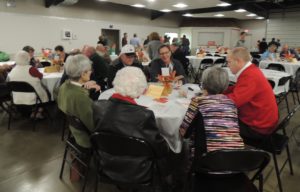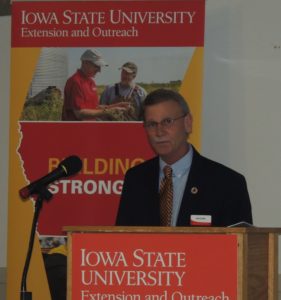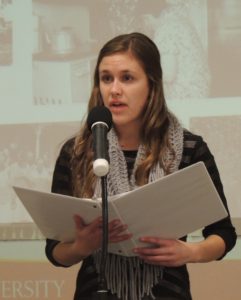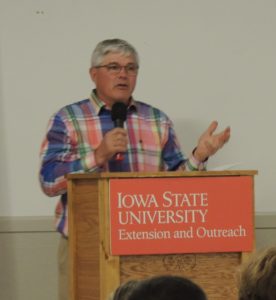 About 100 persons gathered Sunday evening at Clover Hall on the Greene County Fairgrounds to celebrate the centennial of Greene County Extension & Outreach.
About 100 persons gathered Sunday evening at Clover Hall on the Greene County Fairgrounds to celebrate the centennial of Greene County Extension & Outreach.
Greene County Extension council member Doug Rieder was emcee. Extension council chair Tom Heater introduced Robert Dodds, assistant vice president for county services, Iowa State University Extension and Outreach. He congratulated Greene County on behalf of vice president for Extension Cathann Kress.

Dodd reminded the audience that the idea of Extension is to take land grant colleges out to the people. Counties began organizing Extension in 1912. “Today, Extension is everywhere. It is for all Iowans. We serve as a 99-county campus, connecting the needs of Iowans with Iowa State University research and resources,” Dodd said.
He presented the Extension council with a plaque commemorating the centennial.
Senior 4-H members helped serve a meal provided by Home State Bank, Greene County Lamb Producers, Greene County Pork Producers and the Greene County Cattlemen’s Association. Birthday cupcakes were baked at the Ram Bakery at Greene County High School.

A program after the meal featured a recap of Greene County Extension’s first 100 years researched and written by Jacque Andrew, Ruth Freeman and Linda Hedges. The material was drawn from annual reports. Readers were Andrew, Josh Hedges and Emily Heupel.
Greene County was one of the first 24 counties in Iowa to hire a “county agent” by 1917. In the early years, Extension’s mission was to improve Iowa’s farm, home and community life, and the young organization worked closely with the Farm Bureau toward that goal.
Themes emerged as highlights were given decade by decade. By the 1930s, Iowans had learned “that when adversity struck the rural population, Extension would provide the first line of defense.”
In the 1940s, farmers used knowledge provided by Iowa State as they ramped up soil conservation methods and sent soil samples to the lab there. In 1944 there was widespread concern about country schools and their reorganization into the larger “town” schools. According to the report, a county-wide meeting on school reorganization trained 75 community leaders who then lead township meetings that drew 385 people.
In 1955 the Iowa legislature passed a law separating the Extension Service and the Farm Bureau. Until then, the Farm Bureau board was the governing board for the county Extension. The first Extension council was elected in 1955, with members elected from each township. Elmer Eggimann was elected as chair of the new Extension council.

Cultural changes in the 1960s affected Extension and education programs were developed in response. The 1963 annual report noted that “there is less opportunity today for young people to enter farming,” and that “with fewer farm families, small towns serving agriculture find little opportunity for growth. Improved transportation has also had an effect as farm families seek a larger selection of consumer goods and services.”
A 1968 home economics situation statement noted that “families find it more difficult to be a unit with the pressures of modern day living,” and “an increasing number of farm wives joining the workforce causing problems for organizations which depend on volunteer leadership. Special management problems involving the use of time, energy and money, especially if she is working for increased income.”
The statement also noted that a high proportion of Greene County residents are 65 or older and some older people need help to stay in their home.
Farm families turned to Extension in the 1980s when rising interest rates, falling land values and low commodity prices caused some to lose their farms. Extension trained peer counselors to listen to problems and support stressed families. Sixteen volunteer financial counselors were also trained. Extension also helped families analyze their energy use in response to rapidly increasing energy costs.
In 1997, Greene County Extension became the first to build and own its own office. The Extension staff moved from its location on N. Elm to the new/current location on W. Washington St in March of 1998, and the report noted that 224 meetings were held in the meeting room there in 1998. The mortgage was burned in 2003.
In the 2000s, Extension partnered on projects with Greene County Development Corporation, DCAT, Child Care Resource and Referral, HeadStart, the Chamber of Commerce and the public health department’s Healthy Opportunities for Parents to Experience Success (HOPES). Extension provided leadership in forming the Greene County Community Foundation. In 2007 Grand Junction and Scranton participated in the Horizons program, aimed at building community capacity to reduce poverty.
The complete “Greene County Extension: The First 100 Years” is posted on the Greene County Extension webpage.
 Dr Steve Karber provided informal reflections on the impact 4-H has had on his life. He gave a shout-out to Alice Walters, an informal guest of honor at the event. Walters, like Greene County Extension, is 100 years old. Her career as Extension home economist and her volunteer service as a 4-H leader began in the late 1950s and is remembered still.
Dr Steve Karber provided informal reflections on the impact 4-H has had on his life. He gave a shout-out to Alice Walters, an informal guest of honor at the event. Walters, like Greene County Extension, is 100 years old. Her career as Extension home economist and her volunteer service as a 4-H leader began in the late 1950s and is remembered still.
Karber said he learned from Walters “that discipline and decorum is very important.”

He has remained active as an adult volunteer because “you get a lot out of watching children learn to do things and watching them succeed,” he said. He also enjoys being able to engage people, to get to know people from all over the county.
He commended the work of the Fair Association. “We can learn a lesson from them right now. Our county is going through a transition with our school, and we’ve got issues of housing and we aren’t sure how we’re going to afford to do those things. A few years ago we weren’t sure how we were going to afford to make our county fairgrounds up-to-date. We got some young, ambitious members who figured out a way… when we get the beef building done we’re going to have one of the premier facilities for a county anywhere in the state of Iowa.
“It just shows if people can come together as a community we can figure things out and get things done. We need to do the same with the housing issues we have in our county, and we need to do the same with our schools,” he said.
Karber concluded that 4-H has been part of the fabric of his life and is “a model where we can get together and do things together.”
The event was planned by committee composed of Jacque Andrew, Ruth Freeman, Linda hedges, Alicia Heun, Billie Jo Hoskins, Loel Larson, Shari Minnehan, Marilyn Parker, Dough Rieder and the Extension staff.
Members of the Extension council are Jacob Bohnet, tom heater, Joe Gannon, Larson, Amber Lawton, Minnehan, Pam Olerich, Parker and Rieder.
The Greene County 4-H Foundation accepts charitable donations to support the 4-H program. Foundation board members are Laura Ballard, Heun, Hoskins, Kayla Hyett, Karber, Lori Mannel, Lesa Seil and Bill Steussy.
Mannel, Hyett, Ballard and Sue Richardson comprise the Greene County Extension & Outreach staff.
